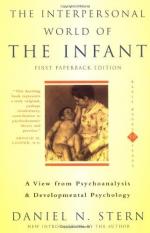
|
| Name: _________________________ | Period: ___________________ |
This test consists of 15 multiple choice questions and 5 short answer questions.
Multiple Choice Questions
1. Stern sees the sharing of ________ states as the most important and the most clinically observable aspect of intersubjective relatedness.
(a) Affective.
(b) Effective.
(c) Motor.
(d) Impact.
2. __________ theory has also given intense emotional states an important organizing role, according to Stern's research.
(a) Spock's.
(b) Psychoanalytic.
(c) Jungian.
(d) Freudian.
3. Children also begin to acquire a capacity to engage in _________ play, or the process of imitating the actions of adults in their lives.
(a) Witness.
(b) Symbolic.
(c) Maturing.
(d) Coloring.
4. Clinicians should keep _________ theory in the background when they practice, according to Stern.
(a) Attachment.
(b) Practical.
(c) Development.
(d) Attunement.
5. _________ in theories of developmental origin, according to Stern, should be maintained.
(a) Flexibility.
(b) Usefulness.
(c) Respect.
(d) Promise.
6. Stern presents a notion of _______ sense of self which helps to develop a therapeutic metaphor because feelings can be turned into particulars which can then allow even closer analysis.
(a) Outer.
(b) Layering.
(c) Inner.
(d) Subjective.
7. Traditional theories are limited because they think of the phases of development as being ______-specific.
(a) Environment.
(b) Action.
(c) Age.
(d) Gender.
8. Non-__________ is a situation in which the infant is unable to engage in an attunement of affect, as in the case of being around a mentally unstable person.
(a) Learning.
(b) Attunement.
(c) Dysphasia.
(d) Movement.
9. The period of __________ of each sense of self is probably a sensitive period and should be focused on in therapy, according to Stern.
(a) Attunement.
(b) Acknowledgement.
(c) Emergence.
(d) Assessment.
10. When searching for causes of ________ personality disorder, for example, different theories look for an experience of abandonment or isolation as a cause.
(a) Anxiety.
(b) Borderline.
(c) Mood.
(d) Paranoid.
11. Self psychology, according to Stern, offers the most ________ value when it suggests search strategies that help construct life narratives.
(a) Medical.
(b) Academic.
(c) Clinical.
(d) Personal.
12. Children can begin to see themselves in a mirror, showing that they can now begin to see themselves ___________.
(a) Actively.
(b) Objectively.
(c) Subjectively.
(d) Impressively.
13. Stern notes there is some evidence from _________ research to support the view that emotional states have an important organizing role.
(a) Ancient.
(b) Memory.
(c) Criminal.
(d) Adult.
14. Children, at this time, also begin to use personal _______ when referring to themselves and others, and they begin to engage in empathic acts.
(a) Movements.
(b) Pronouns.
(c) Adjectives.
(d) Subjects.
15. Stern seeks to describe the development of the infant's sense of __________ in this book.
(a) Self.
(b) Other.
(c) World.
(d) Family.
Short Answer Questions
1. _________ believed that in the first few months of life that an infant had a protective shield against stimuli that might affect development.
2. Neurological and ethological viewpoints provide evidence that a sense of ______ is more sensitive during its formation.
3. Stern says that more __________ is needed since the ideas he presents in this book are merely hypotheses.
4. The interpersonal ______ created by attunement is crucial for helping an infant realize that internal feeling states can be shared with others.
5. Attunement is often seen as a stepping stone to __________, according to some researchers.
|
This section contains 463 words (approx. 2 pages at 300 words per page) |

|




